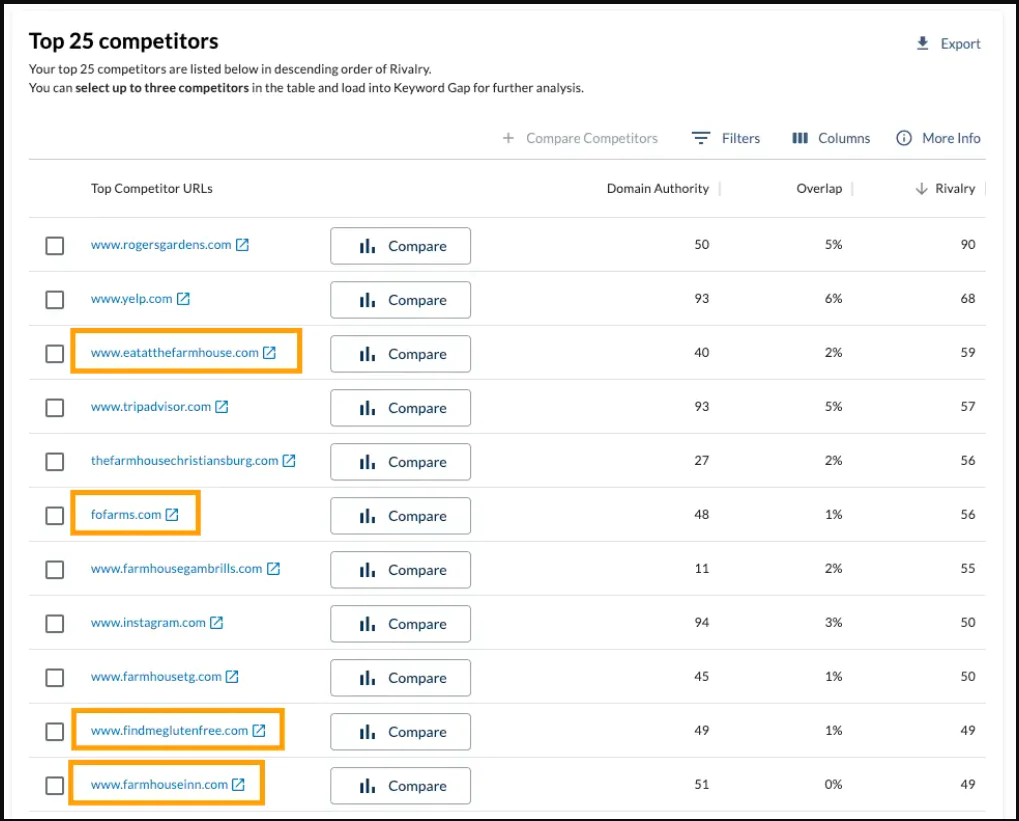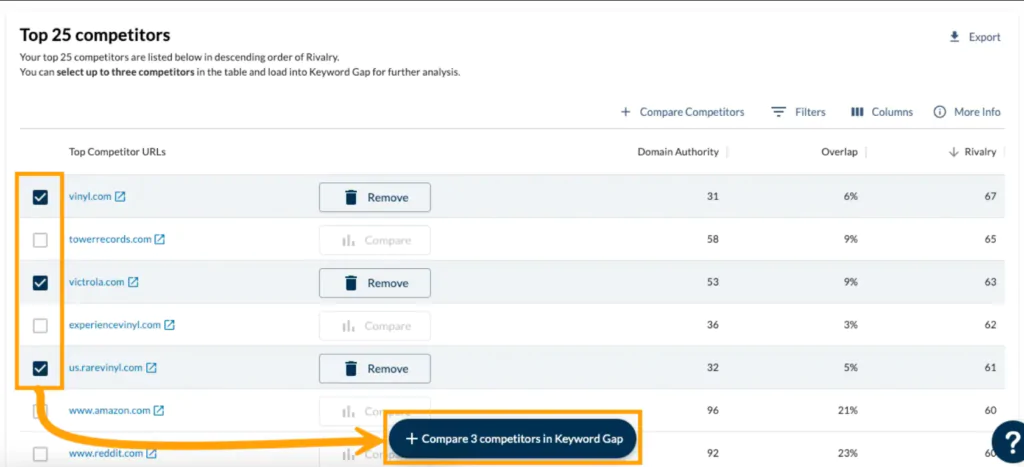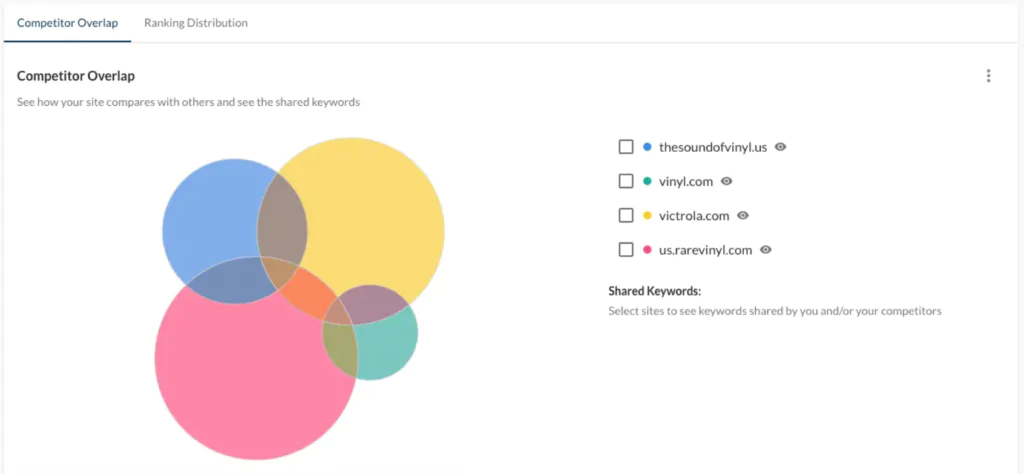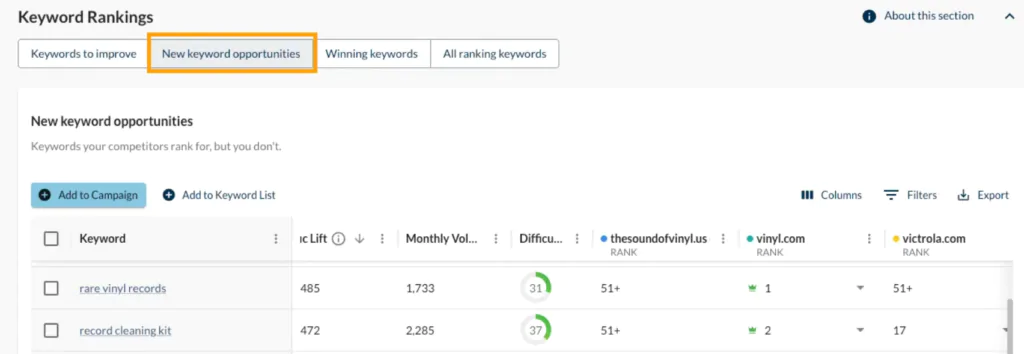“When I Google this keyword, our competitor is outranking us — why? What are we doing about it?” When clients or stakeholders bring this up, we want to be prepared — we don’t want to be in the dark about the keyword in question or its search landscape. One of the first steps is to find competitor keywords they’re ranking for, so we can better understand what’s driving their visibility.
We all know that the higher we rank in search results, the more clicks we’re likely to get. And with an increasing number of SERP features and AI summaries popping up, it’s more important than ever to snag that top spot in organic results to boost our traffic.
Beyond just driving traffic by outpacing competitors in the SERPs, doing some competitor keyword research can reveal content gaps in your own strategy and help enhance your overall SEO game.
So, the big question is — do you know what keywords your competitors are ranking for? If you’re unsure, don’t worry! I’m here to guide you through finding this information, along with some handy tips and tricks, all within Moz Pro. I’ll walk you through how to identify your competitors, discover their ranking keywords, and analyze their content for extra insights.
Let’s jump right in!
To know about Social Media Marketing Packages, Read the Blog: Social Media Marketing Packages in India 2025.
Tips for spotting your competitors
1. Your online competitors might not be the same as your “real-life” competitors
This is especially true if you run a physical business, like a brick-and-mortar store, a service area business, or any venture that involves face-to-face interactions with customers. While it’s important to keep an eye on local competitors in your industry, don’t forget about those online rivals. Take the time to research which businesses—whether they have a physical presence or are purely online—are showing up in search results for your target keywords, industry, and niche. This will give you a more comprehensive view of your competitive landscape and help you discover competitors you might have overlooked.
Pro tip! If you own a local business, consider using Moz Local to keep tabs on your rankings, identify competitors in your area, and see who’s making waves in Google Maps results.
2. Different products, services, or niches can have varying competitors
Depending on what your business offers, you might find yourself keeping tabs on more than one group of competitors. For instance, if I run a cupcake shop that ships cupcakes and also provides paid online cooking classes, the competitors for my cupcakes will likely differ from those for my cooking classes. It’s crucial for me to research both areas to fully grasp how I’m appearing in search engine results for my target keywords.
3. Making assumptions about your competitors can waste your time and resources
Avoid the temptation to guess who your online competitors are. This can lead to misdirected content and create gaps in your overall SEO strategy. When conducting a thorough competitor keyword analysis, it’s vital to ensure you’re tracking the right players and looking at the appropriate search results.
4. Stay grounded
When identifying your competitors, it’s important to be realistic with yourself and your team about who you can genuinely compete with. If you’re a smaller business and see major brands like Amazon or Apple showing up in the search results for your keywords, it’s unlikely you’ll be able to compete with or surpass them in those results. Instead of striving to be number one against those giants, focus on identifying the highest-ranking site or page that’s more in line with your business’s size and authority as a more attainable target.
Pro tip! Want to see how your brand measures up against the competition? With Moz’s Brand AuthorityTM metric, you can gain a clear understanding of your brand’s strength and visibility. Check out your score compared to your top SERP competitors using the Domain Overview tool.
To know about Advantages and Disadvantages; Read the Blog: Advantages and Disadvantages of Social Media: Guide.
Finding your True Competitor
The True Competitor tool in Moz Pro simplifies the process of identifying your competitors by allowing you to search based on your root domain, subdomain, or subfolder. This flexibility helps you pinpoint competitors related to various aspects like niche, products, services, verticals, and business types. Let’s dive into an example to see how this tool operates.
Take Roger’s Gardens, for instance. This Southern California nursery boasts a physical location, complete with an on-site restaurant on a subdomain of its main site, along with online shopping, classes, a blog, and more. Since each of these business components might attract different competitors, I can start by entering the subdomain for Farmhouse (the restaurant at Roger’s Gardens) to uncover the top search engine competitors for that specific segment of their business.

After I click on Find Competitors, I notice that in the list of the top 25 competitors, there are several restaurants and farms with names that are quite similar, all vying for attention in the search results. I also spot an Inn and a few niche sites, like findmeglutenfree.com, that cater to specific cuisines.

Next, let’s try entering the subfolder for their blog to see how these results change.

These days, we’re noticing that gardening-focused websites—like online plant shops, blogs dedicated to particular plant species, and comprehensive plant guides—are making their way onto the Top 25 competitors list.
To know about SEO vs Digital Marketing; Read the Blog: SEO vs Digital Marketing | What is the Difference?

Have you noticed how competitors can vary so much between subdomains and subfolders? Understanding this can really help you stay focused and work more efficiently. Once you’ve compiled your list of competitors, how do you decide which ones to dive deeper into? Luckily, the tool offers some handy metrics to help you refine your choices.
- Domain Authority (DA)Ⓡ is a unique metric created by Moz that ranges from 1 to 100, helping to predict how well a domain might rank on Google. This prediction is based on a machine learning algorithm that analyzes various link metrics. When you’re checking out potential competitors, it’s wise to focus on sites that have a DA similar to yours. Keep in mind that DA is a relative measure, so it’s best used for benchmarking. For instance, if my site has a DA of 50, comparing it to a site with a DA of 80 wouldn’t be very helpful.
- The Overlap score represents the percentage of keywords that you and a competitor share, based on your rankings in the top 10 search results. A higher percentage means you’re competing for more of the same search results.
- The Rivalry metric is another score, also on a scale from 1 to 100, that takes into account your Domain Authority (DA), your competitor’s DA, keyword overlap, keyword volume, and your rankings to pinpoint your toughest competitors. A higher Rivalry score suggests a more formidable rival.
By default, your Top 25 competitors table will be organized according to the Rivalry metric. So, when I’m choosing which competitors to dig deeper into, I usually look for sites that have a higher Rivalry score and Overlap, along with a Domain Authority that’s close to mine.
For example, if I’m examining the blog subfolder, I’d likely take a closer look at provenwinners.com and epicgardening.com. They both feature gardening blog content (not just online shopping) and share keywords with a similar DA to mine.
Pro tip! For more insights on how to identify your competitors, check out our How to Do an SEO Competitor Analysis Guide.
Read this blog also: Discover the True Ecommerce Website Development Cost in India: A Comprehensive Guide.
Find competitor keywords
Now that we’ve pinpointed who our competitors are, it’s time to uncover the keywords they’re ranking for. Knowing which keywords are working for them—and where they’re outshining you—can really help you identify gaps in your strategy and discover ways to enhance your current content.
With Moz Pro, we can easily track down our competitors’ keywords using the Keyword Gap tool.
If you’ve already used True Competitor to figure out your main rivals, just select them and hit Compare to access the Keyword Gap tool. If not, no worries! You can go straight to Keyword Gap and enter your competitors’ names manually.

Pro tip! If you have real-life competitors that might not be directly in your niche, manually entering them can be a smart move. For instance, a coffee shop could benefit from checking out the keywords of the bookstore right next door to discover some local, niche overlaps.
To know about Online Presence; Read the Blog: What is Online Presence? Its Importance in your Business.
The Keyword Gap tool is your go-to for uncovering keyword opportunities and enhancing your keyword strategy. Once you’ve added your competitors—whether through True Competitor or by entering them yourself—the tool will seamlessly gather and organize the ranking keywords for both your site and your competitors in a user-friendly format.
To kick things off, you’ll be greeted with a competitor overlap chart that uses a Venn diagram to illustrate how the ranking keywords from all the sites intersect. This interactive chart is super handy; you can update it by clicking on the sites listed to the right, and if you hover over it, you’ll get even more details. Plus, if you want to save it, just click the three dots in the top right corner to export it as a .png file.

Keywords to improve
Just below this handy diagram, you’ll find the Keyword Rankings table, where the real treasure lies. The first thing you’ll notice in this table is the section labeled Keywords to improve. This is a compilation of all the keywords where at least one of your competitors is ahead of you, along with your own ranking within the top 20 results. Think of these as your keywords that are within reach. Use this list to pinpoint pages on your site that are performing decently but could use a little extra attention to elevate your rankings. And don’t forget to keep an eye on the Traffic Lift metric — this tells you how much traffic Moz estimates you could gain by surpassing your competitor.
Read about US SEO Service: SEO Company in US.
Let’s take a quick look at an example. Here, we see that victrola.com is ahead of thesoundofvinyl.us for the keyword “record sizes.” By outpacing their competitor, thesoundofvinyl.us could potentially see an increase of up to 274 visits a month. If we click the arrow in the rank column, we can pinpoint exactly which pages are ranking for this keyword, allowing us to compare and identify opportunities to enhance our content.

Pro tip! Clickthat Analyze SERP button to check out the other pages that are ranking for this keyword. You’ll also get some extra metrics that can really help you grasp what kind of content is doing well out there.
Keyword opportunities
Now that we’ve got a solid list of keywords we’re already competing for, let’s dive into how we can uncover some fresh keyword opportunities. The great news? We don’t even need to change tools to do this! All we have to do is click on “New keyword opportunities” from the pre-set filters at the top of the Keyword rankings table in Keyword Gap.

This feature will automatically generate a list of keywords where my competitors are making strides, but I’m not, which is a fantastic way to uncover content gaps and new opportunities.
Taking our vinyl record example, I noticed that thesoundofvinyl.us isn’t ranking for “rare vinyl records” or “record cleaning kit” — both of which they actually sell. This could be a great chance to refresh the pages related to those products or even create a new category page for rare vinyls, write a blog post on how to care for your records, or put together a buying guide for these items.
With these filtering options, I’m on the right track to compiling a list of competitor keywords to assess, monitor, and hopefully start ranking for.
But what if I want to dive a little deeper? Or maybe there’s a specific landing page, blog section, or set of product pages that I’m eager to compete against?
Read about SEO Services in Ghaziabad: SEO Services in Ghaziabad | SEO Company to Rank #1.
By analyzing your competitor’s keywords at the page or subfolder level, you can uncover related content ideas and take a closer look at their overall strategy. Luckily, the Keyword Gap tool lets you compare ranking keywords and spot opportunities at both the page and subfolder levels with just a quick update to the drop-down selection.

If you prefer, you can also check out the Explore by Site feature in Keyword Explorer. Just enter a page or site, and you’ll be able to see its ranking keywords, including those that are branded!

Pro tip! After you pinpoint those important keywords, make sure to add them to a Keyword List for deeper analysis or include them in a Moz Pro Campaign to keep an eye on your rankings as they evolve over time.
Analyze competitor content
Right now, we’ve got a solid list of keywords to work with, but I want to share one more trick that can really enhance your competitive keyword research. Taking a look at what content is performing well for your competitors is a fantastic way to understand what kind of content people are interested in within your industry, products, or services. The Top Competing Content tool is perfect for diving deep into this information.
Once I enter my domain and my competitors (or switch over from Keyword Gap), I can pull up a list of their pages that are ranking higher than mine, along with the keywords they’re using, all organized by page.

By taking a closer look at the Top Competing Keywords column, I can uncover more details about the keywords that the page is ranking for, as well as the specific URL on my site that it’s managing to outrank.

Now that I have this information, I can pinpoint more keywords to target and take a closer look at our content side-by-side to find areas where we can improve. As I analyze competitor content at this stage, there are a few key things to keep in mind.
- First up is keyword targeting and placement. Think about how and where they’re using the target keyword you’re focusing on, how frequently it appears, and whether it feels natural within the text. Also, take note of any variations they might be using. Identifying additional keywords can help you create keyword clusters, which could lead to more traffic for your pages.
- Next, consider the quality and format of the content. Is it well-written? What format is it presented in? Pay attention to on-page elements like videos and graphics. Do you have similar elements in your content? Could you enhance them or add any that are missing?
- Lastly, look for content gaps in your competitors’ work. Are there topics or points they’re not covering that you could include in your own content? Filling in those gaps might just give you the edge you need to climb higher in the search engine results!
Read about Digital Marketing Agency in Gurgaon: Choosing the Best Digital Marketing Agency in Gurgaon: Your Complete Guide.
Bonus tip! Examine the SERP to find additional context
I just can’t help but share a great bonus tip! Before we finish up, I want to introduce you to an amazing tool that can help you uncover any competitors you might have overlooked and keep tabs on the constantly shifting SERP landscape for your target keywords.
In the Explore by Keyword section of Keyword Explorer, you’ll find the SERP Analysis feature. It gives you a clear look at the first page of the SERP, showcasing the various SERP features, along with important website and brand health metrics like Domain Authority, Page Authority, and Brand Authority, plus link metrics—all in one convenient view.

If there’s a particular keyword or a group of keywords that really matter to your brand, using this tool to check out the SERP can be super helpful. It allows you to see other sites in your niche that you might be up against. Plus, this feature can also help you spot potential opportunities to snag some SERP features for your own site.
Wrapping up
Well, there you go! You’ve got a focused list of your competitor’s keywords along with some helpful tips for diving deeper into their content and finding new opportunities. If you’re eager for more insights on conducting a thorough competitor analysis, I suggest taking a look at our How to Do An SEO Competitor Analysis Guide. It even comes with a useful downloadable worksheet to help you out! Now, all that’s left is to put your newfound knowledge into action. Catch you later!

